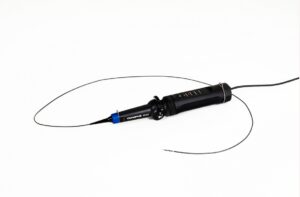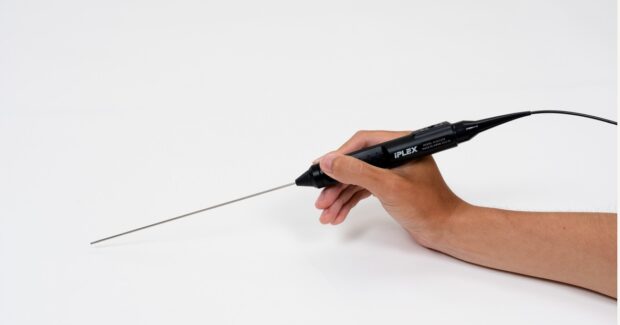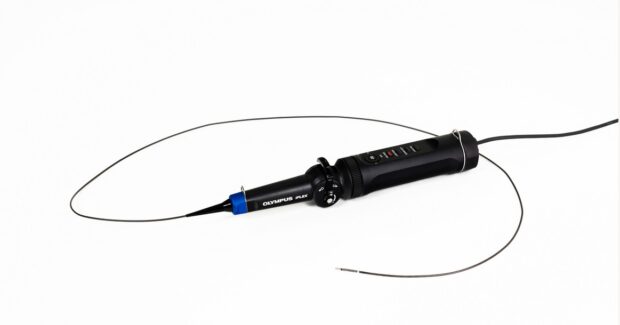Machined Metal Parts: Tips to Ease the Inspection Process
Selecting a videoscope with a suitable scope diameter along with ergonomics and durability can help inspectors stay comfortable and productive.
Posted: February 17, 2024
Machined metal parts are used across various industries. Aircraft and automotive vehicles use numerous quantities and types of metal parts varying from cast parts to fuel pipes. The increase in electric vehicle production has made metal parts critical components for this growing industry. As machined metal parts become increasingly miniaturized and complex to meet industry needs, so do the tools used to inspect them. This article explores these industry challenges in detail and shares tips to ease the inspection process.
The Visual Inspection Process for Machined Metal Parts

In the process of machining metal parts, inspections for burrs and residual sand are generally carried out after metal processing to help ensure the quality of the parts. For example, when metalworking is performed using drills or other machining tools, burrs may remain in the cut areas or residual sand may be left over after casting. In these cases, inspection is required.
Frequent inspection of burrs on cast parts in automotive manufacturing is particularly important. For example, if burrs or residual sand remain on the engine block and enter cooling parts such as the radiator or the housing of the motor, performance problems can occur.
In general, inspections take place at every part of the manufacturing process, so the number of inspections is high — from hundreds to thousands per day. Inspections to confirm residuals such as burrs are usually performed visually. However, the inspected parts are small, and there are many places that cannot be visually inspected directly.
In this case, an industrial videoscope is an effective option. A videoscope is an advanced type of borescope used to remotely inspect areas that are not otherwise visible. Equipped with a CMOS sensor and lens at the tip, a videoscope can be inserted into hard-to-access and narrow spaces where the inside of the object is inspected visually using images. Videoscopes with advanced optical technology can reproduce images that closely match what we see with our eyes. These images reduce the possibility of overlooking inspection points.
One of the key benefits of videoscope technology is that it enables nondestructive testing of parts. In other words, the scope can inspect inside parts without the need to destroy or disassemble them. During destructive testing of parts, inspectors randomly decide which parts should be inspected destructively. With this method, the inspector only can guess the quality status of other parts from its inspection result. Along with these quality issues, destructive testing is expensive and wasteful as it damages valuable parts that could have been used.
Smaller Metal Parts Bring New Inspection Challenges and Solutions
Videoscopes are also easier to handle and learn than other nondestuctive testing devices, such as ultrasonic flaw detectors. In general, a 4 mm or 6 mm diameter videoscope is used in the inspection process.
However, the miniaturization and increasingly complex shapes of metalworking parts have made it difficult for videoscopes to reach inside them. For example, in automotive parts manufacturing where borescopes are commonly used for inspection, parts for electric vehicles tend to be smaller to reduce their power consumption. The same is true for gasoline-powered vehicles, where engines are being downsized to improve fuel efficiency.
An ultra-thin videoscope is often used to inspect in-vehicle devices and batteries at manufacturing sites for electric vehicle parts. The scope is used to check the contact points on the circuit board after assembly or to check the internal status. However, in many cases the gap is small and only a scope with diameter of around 2 mm can be inserted. Ultra-thin videoscopes are also used to inspect turbochargers for gasoline-powered vehicles. Unless the scope is thin and easy to insert, it is difficult to inspect deep inside the turbocharger.
In the aviation industry, where demand for borescope inspections is high, the rise of low-cost carriers (LCCs) has led to an increase in the number of medium-sized aircraft in operation. This has driven greater demand for narrow borescopes with diameter of around 2 mm, which can fit into smaller aeroengine parts. For example, the gearbox next to an aircraft engine has a complex and narrow structure that is difficult to inspect without the use of an ultra-thin diameter borescope. In the aircraft and automobile manufacturing fields, many parts require ultra-thin diameter borescopes.
However, ultra-thin borescopes present several operational issues. The first challenge is the frequent occurrence of breakdowns. Ultra-thin borescopes have extremely thin scopes compared to a standard borescope, and they tend to fail easily. Further, the smaller size and more complex structure of the parts makes it difficult to insert the scope smoothly, and the ongoing contact with internal parts can lead to a damaged and inoperable scope. Frequent breakdowns increase operational costs, which affect the cost of production. For quality maintenance and inspection efficiency, it is important to select an ultra-thin videoscope with enough durability for easy insertion, minimizing damage to the scope during inspection.
An ultra-thin videoscope with a tungsten or stainless-steel blade, which is durable and effective in protecting the curved section, can reduce damage caused by repeated insertion. Generally, several thousand parts are inspected per day in the inspection process for automotive parts, so it is difficult to eliminate damage caused by contact between the scope and the inner wall of parts. Videoscopes designed with a durable braid to protect the scope during insertion can reduce the frequency of failures and maintenance costs.
The ease of inserting the scope is also important when repeatedly inspecting small, narrow areas. When inserting a scope inside parts with a complicated structure, the scope is inserted while controlling the articulation. If the inspection point is narrow, the scope will inevitably be damaged due to the increased frequency of contact between the scope and the inner wall of the part.
In particular, the surfaces of castings used as automotive parts can be rough. Repeated insertion while making contact with the inner wall tends to cause significant damage to the scope. The articulation section is particularly vulnerable to damage. If it breaks down, costly and time-consuming repairs are required. Also, a certain period of downtime must be considered. To maximize inspection efficiency and minimize maintenance costs, it is important to select a videoscope with intuitive articulation control and easy insertion even in parts with complex structures.
Another challenge is fatigue, as inspectors can strain their eyes, hands, and posture as they perform many remote visual inspections throughout the day. Managing fatigue can be difficult when parts are small, as inspection precision is required. It is recommended to select an ergonomic videoscope designed to reduce postural strain when holding the scope or checking inspection images.
Consider the following example. During remote visual inspection, it is common to control the scope’s articulation by looking at the monitor while holding the control unit. Since inspection is performed while controlling the scope’s articulation with the fingers, a heavy or unbalanced controller can put strain on the inspector’s hands. Selecting a videoscope with a light or balanced controller can reduce this fatigue.
The placement and size of the monitor used to view the inspection images are also important factors to reduce strain on the eyes and body. If the monitor is small, the eyes will become tired. If the monitor’s location is fixed, the inspector must stay in the same position for long periods of time, straining the neck and back. Large monitors with portability help reduce fatigue.
Since remote visual inspection is important to maintain product quality, it is important to select a videoscope that is comfortable to use from the inspector’s perspective. Along with keeping workers comfortable, an ergonomic videoscope helps inspectors complete their inspections efficiently so products are shipped on time. Selecting a videoscope with a suitable scope diameter along with ergonomics and durability can help inspectors stay comfortable and productive.


















